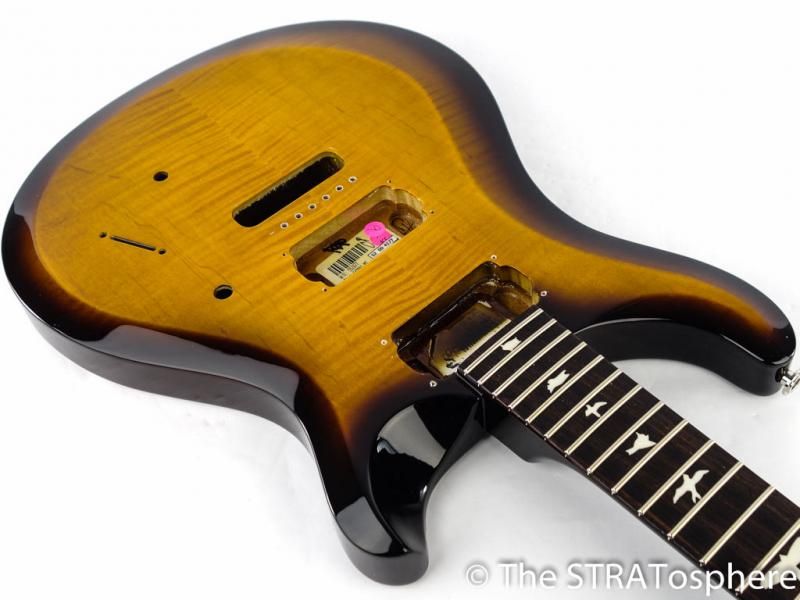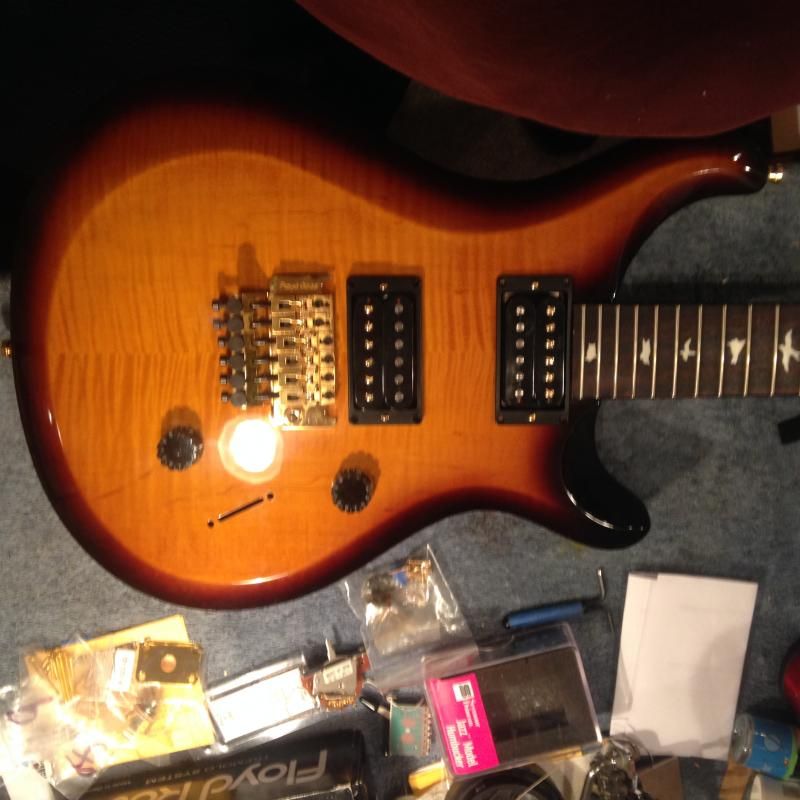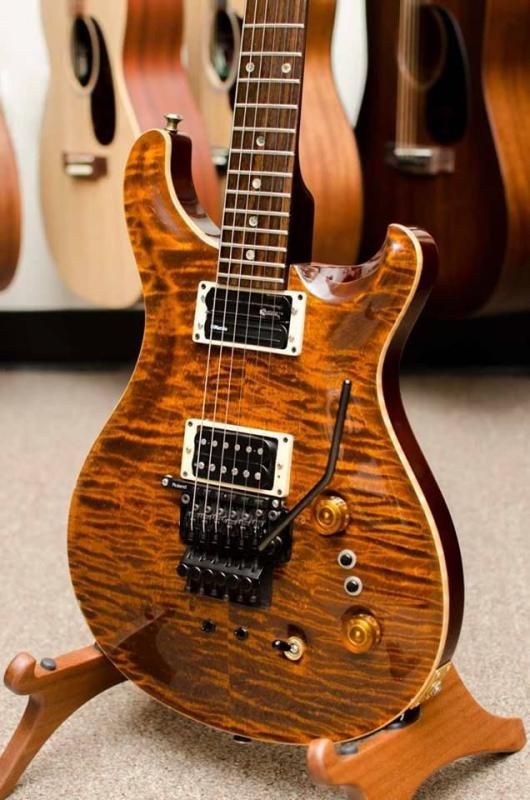Anyway, I digress. Fast forward to 2002 or so, and I saw a Journey concert and Neal Schon was using PRS guitars. Only, as usual, Neal's looked nothing like the production models! His had Floyd Rose bridges on them, Grover Tuners and sustainers built in! To be clear, I am not a huge Neal Schon fan-boy. I am a real fan of Neals vision of a cool guitar. It should have a Floyd, it should have a set neck, the best hardware available, and it should have two humbuckers. I share the same vision. So for the past 15 years I have been very passively searching for the right PRS guitar to meet my needs. No way was I going to spend $3-4K on a new PRS 24. I thought about a bolt-on, but decided that cheaping out was not the way to go. My father recently started playing guitar and he had a decent MIM Fender Strat. Well, he is a huge Santana fan and just a few weeks ago he blew my mind and bought himself a brand new (leftover) Santana model. He brought it over and let me put it throught its paces. Needless to say, I was hooked. The guitar played great, and sounded even better. The trem also impressed, and stayed in tune. This was just the push I needed, and I amped up my search.
I decided that I wanted the traditional PRS shape and headstock, not the Santana's more symmetrical shape and (honestly) blob shaped headstock. It didn't take long before I found the perfect candidate, on eBay. There is a huge reseller on eBay, who essentially parts out guitars. Selling necks, bodies, and parts, presumably for a profit. Recently even parting out and selling higher end guitars, like real USA Les Pauls and PRS's. He has one of the new S2 PRS guitars for sale, and it matches all my specs. Meaning it is the 24 fret tremelo model, finished in a nice McCarty tobacco burst. Even better, it is brand new, and selling for roughly half the price of a completed guitar. So I pulled the trigger. I mean, this is a perfect USA PRS, no hardware, which I would have junked anyway and no case, nothing else to jack up the price.
I don't want to get too in depth, but I feel an explanation of the S2 series is in order, here. The S2 series is PRS recent foray into less expensive, US built guitars. It falls nicely in between the Korean made SE line, and their top of the line or 'Core' models. The interesting thing is how PRS is building these guitars, and then selling them for 1/2 price or less of their Core models. For starters, they use smaller pieces of wood for the necks. A Core PRS neck is made from a huge 12/4 (roughly 4x4) single piece of mahogany. The S2 uses a much thinner piece of wood, roughly a third of the size, with a traditional glued on headstock, with a scarf joint. Funny thing here is, we all know how much stronger and more stable a glued on scarf joint is, compared to a one-piece neck?! Next, the bodies are the same, mahogany, with a maple cap. Of course, you do not get a 10 top on the S2, more like a 5 top! lol. In addition, the arch top carve on the S2 is completely CNC shaped. The Core models are shaped largely by hand, with the little divots for the controls etc. Curiously, the cavity covers, which are identical, are not recessed on the S2 line. The paint processes are also different. On the Core line they use the latest technology water based paints. On the S2 line, they reverted to the less expensive poly finishes, used by PRS into the late 90's. Curiously again, a lot of purists prefer the old finishes and the sound of the previous generation PRS, to the new ones?! Lastly, and here is the killer, is the hardware. PRS really cheaped out on the S2 lines hardware. They use the trem unit off of the Korean SE models. They use locking tuners, that look the same, but are Asian made, with no screw tabs on the back. The pickups are also 'PRS Designed' units, which are supposed to be Asian made exact reproductions of their Core model pickups, Oh yeah, it goes without saying the S2's don't come with a case, just a good quality gig bag. So those are the big money differences in the guitars. However the S2's are built in Maryland, use the same woods, fingerboards, frets, all the structure and bones, where it counts they are all the same.
So what I got is a real, American Made PRS carcass, with no substandard Asian hardware, that I am going to replace, anyway. Seriously, my only criticisms of PRS, in general are that they fall into the 'overbuilt' category, to me. The insane tops, wood bindings, abalone inlays, all those extraneous appointments, -- I can do without. The S2 line strips all of that away. You do get the PRS signature birds, but they are plain white ivoroid, not abalone. Here are a couple of pics of my newest project guitar:
Of course, if you know me, you know what I have in mind! I am going to Floyd this guitar, with a top mounted, non-recessed Floyd. In addition, I am going to put in Duncan pickups a DeMartini RTM and a Jazz model. I will also use top of the line, gold hardware, throughout. Here is a very quick mock up:
The trem is going to have to be ever so slightly recessed, due to the shallow neck angle. Likewise, the locking clamp will have to be mounted on a shim, or a shelf. Other than that, this should be a very straightforward and rockin' guitar!
Here are a couple of bonus picks of one of Neal's guitars, for sale on eBay:





No comments:
Post a Comment